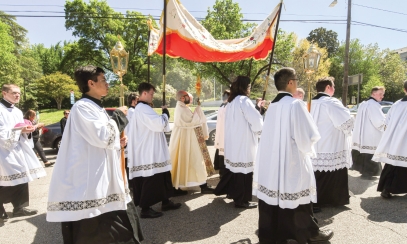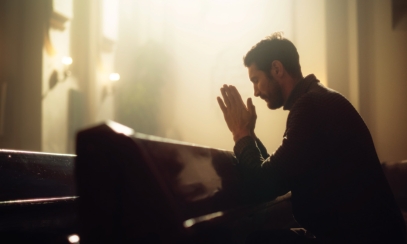
The Eucharist: More than Meets the Eye
Lee este artículo en español (Spanish Language Version)
Those of us of a certain generation are familiar with a popular toy, television show and movie franchise that talks about its main subject matter as being “more than meets the eye.” I know many of you sang that phrase in your head when you read it, but for the rest of you, we’re referencing Transformers. But the idea of something being more than meets the eye is not just a fictitious notion limited to comic books and kids’ shows. It is a fact of life, and it is an essential element of our faith and how we live it out.
Lee este artículo en español (Spanish Language Version)
Those of us of a certain generation are familiar with a popular toy, television show and movie franchise that talks about its main subject matter as being “more than meets the eye.” I know many of you sang that phrase in your head when you read it, but for the rest of you, we’re referencing Transformers. But the idea of something being more than meets the eye is not just a fictitious notion limited to comic books and kids’ shows. It is a fact of life, and it is an essential element of our faith and how we live it out.
The expression is a fitting way to describe the sacraments, most especially true in our consideration of the Eucharist. The Real Presence defies our sensibility. Rather than being a denial of sensibility, it embraces it as the outward appearance of bread and wine making Christ’s presence tangible and available to us.
The belief of transubstantiation is a philosophical way of saying that the outward appearances — the term we use is “accidents,” meaning that what it looks like is not essential to its nature — of the Eucharist are distinct from the true, inward reality.
The “what it is” — the term we use is “substance” or real form — has been transformed into something new. Now there is an element of mystery because what is experienced is more than what we encounter with our senses even though the encounter takes place through those senses. This combination of tangibility and that which transcends it is reflective of the Incarnation, the seemingly paradoxical nature by which Christ, who appears as a human being, gives us access to the divine, more than his outward appearance.
This “more than meets the eye” character of the Eucharist extends to more than the event that we call transubstantiation; it is also true of the effects of the Eucharist. We have mentioned the transformative grace of the body of Christ numerous times. Yet, it is worth reiterating that as we receive the Eucharist, we also become “more than meets the eye.” We receive the Lord’s presence and are called to carry it into the world, although this may not be immediately perceptible to others, maybe not even to ourselves.
Remember, the Eucharist teaches us that the outward signs give access to inward reality. The transformative effect of the Eucharist reshapes the way we see the world. Eucharistic, or sacramental, vision helps us look beyond outward appearances and find truth that lies beneath. It changes our way of envisioning other people and ourselves by shining a new light on them. This new light carries ethical implications as we respond to the presence of Christ and the sometimes obscured image of God that we encounter in others. This new way of seeing leads to a new way of doing. Our outward actions as Christians are revelatory of what lies beneath the external, giving tangible expression to the deep and generous love of God in a way that is ultimately nourished by the Eucharist.
Our outward acts, in turn, can have a transformative effect on others as we give witness to the transformative gift of the Eucharist to all those we encounter.
The Eucharist gives us the vision and strength to participate in the Lord’s work as “transformers” of the world.
Michael Martocchio, Ph.D., is the secretary of evangelization and the director of the Office of Catechesis and Christian Initiation. Email him at mmartocchio@charlestondiocese.org.



